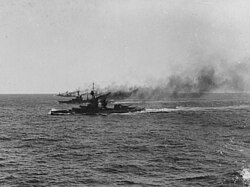The 4th Battle Squadron was a squadron of the British Royal Navy consisting of battleships. The 4th Battle Squadron was initially part of the Royal Navy's Home Fleet (1912–14) and then the Grand Fleet after the outbreak of the First World War. The squadron changed composition often as ships were damaged, retired or transferred.
| 4th Battle Squadron | |
|---|---|
 The ships of the 4th Battle Squadron, Benbow, Agincourt, Bellerophon, and Temeraire steaming in the North Sea, 1915. | |
| Active | 1912–30 March 1919;[1] reformed |
| Country | |
| Branch | |
| Size | Squadron |
| Part of | Home Fleet Grand Fleet |
August 1914
editOn 5 August 1914, the squadron was constituted as follows:[2]
January 1915
editBy January 1915, the composition had changed slightly:[2]
- HMS Agincourt
- HMS Bellerophon
- HMS Dreadnought
- HMS Temeraire
- HMS Benbow
- HMS Emperor of India
- HMS Erin
Battle of Jutland, June 1916
editAs an element in the Grand Fleet, the squadron participated in the Battle of Jutland. During the battle, the composition of the 4th Battle Squadron was as follows:[3]
- Third Division
- HMS Iron Duke, fleet flagship of Admiral Sir John Jellicoe; Captain Frederic Dreyer;
- HMS Royal Oak, Captain Crawford Maclachlan;
- HMS Superb, flagship of Rear Admiral A. L. Duff; Captain E. Hyde-Parker;
- HMS Canada, Captain W. C. M. Nicholson;
- Fourth Division
- HMS Benbow, flagship of Vice Admiral Sir Doveton Sturdee; Captain H. W. Parker;
- HMS Bellerophon, Captain E. F. Bruen;
- HMS Temeraire, Captain E. V. Underhill;
- HMS Vanguard, Captain J. D. Dick;
January 1917
editFollowing the Battle of Jutland, the 4th Battle Squadron was reorganized, with Colossus, Hercules, St. Vincent, Collingwood and Neptune all transferred from the 1st Battle Squadron. In January 1917, the squadron was constituted as follows:[4]
- HMS Bellerophon
- HMS Temeraire
- HMS Vanguard
- HMS Superb
- HMS Colossus
- HMS Hercules
- HMS Neptune
- HMS St. Vincent
- HMS Collingwood
After the loss of HMS Vanguard in July 1917, HMS Superb and HMS Temeraire were detached to the Mediterranean in 1918. HMS Dreadnought rejoined the squadron as flagship in March 1918.
Postwar
editThe squadron was dispersed in February 1919, appears to have been formally dissolved in March 1919, but then reformed.
In September 1920 Rear Admiral Richard Webb was posted to the Mediterranean as Rear-Admiral 4th Battle Squadron and Second-in-Command, Mediterranean Fleet. He served there until 1922.[5]
Admirals commanding
editPost holders as follows:[6][1]
| Rank | Flag | Name | Term | Notes | |
|---|---|---|---|---|---|
| Admirals, Commanding, 4th Battle Squadron | |||||
| 1 | Vice-Admiral | Sir Sir Charles Briggs | 1 July 1912 – 1 July 1914 | ||
| 2 | Vice-Admiral | Sir Douglas Gamble | 1 July 1914 – 7 February 1915 | ||
| 3 | Admiral | Sir F. C. Doveton Sturdee | 7 February 1915 – 13 February 1918 | ||
| 4 | Vice-Admiral | Sir Montague Browning | 13 February 1918 – 3 December 1918 | ||
| 5 | Rear-Admiral | Douglas R. L. Nicholson | 3 December 1918 – 1 February 1919 | temporary command | |
| 6 | Vice-Admiral | Sir Montague Browning | 1 February 1919 – 1924 | ||
Rear-Admirals, Second-in-Command
editPost holders as follows:[1]
| Rank | Flag | Name | Term | Notes | |
|---|---|---|---|---|---|
| Rear-Admiral, in the 4th Battle Squadron | |||||
| 1 | Rear-Admiral | Alexander Duff | 22 October 1914 – 12 June 1916 | ||
| 2 | Rear-Admiral | Ernest F. A. Gaunt | 12 June 1916 – 23 June 1917 | ||
| 3 | Rear-Admiral | Roger J.B. Keyes | 23 June 1917 – 25 September 1917 | ||
| 4 | Rear-Admiral | Douglas R. L. Nicholson | 22 September 1917 – 3 December 1918 | acting squadron commander | |
| 5 | Rear-Admiral | Michael Culme-Seymour | 1 January 1919 – 1 September 1920 | ||
| 6 | Rear-Admiral | Richard Webb | 1 September 1920 – 27 July 1922 | ||
| 7 | Rear-Admiral | John D. Kelly | 27 July 1922 – June 1923 | ||
| 8 | Rear-Admiral | Hugh D. Watson | 26 June 1923 – October 1924 | ||
Notes
edit- ^ a b c Harley, Simon; Lovell, Tony. "Fourth Battle Squadron (Royal Navy) – The Dreadnought Project". www.dreadnoughtproject.org. Harley & Lovell, 1 August 2017. Retrieved 27 December 2017.
- ^ a b Dittmar & Colledge
- ^ MacIntyre
- ^ Dittmar & Colledge p. 20.
- ^ "Senior Royal Navy appointments" (PDF). Archived from the original (PDF) on 15 March 2012. Retrieved 4 October 2014.
- ^ "Senior Royal Navy appointments" (PDF). Archived from the original (PDF) on 11 July 2011. Retrieved 4 October 2014.
External links
editReferences
edit- Dittmar, Frederick J; Colledge, J. J. (1972). British Warships 1914–1919. London: Ian Allan Publishing. ISBN 978-0-7110-0380-4.
- MacIntyre, Donald (1957). Jutland. London: Evans Brothers. ISBN 978-0-330-20142-1.